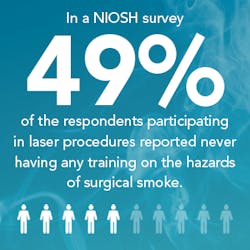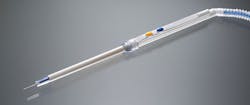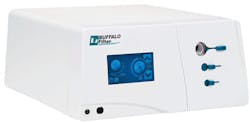No healthcare worker would dare light a cigarette on the job or accept that behavior from anyone else. In fact, smoking anywhere inside a hospital is strictly prohibited. Or is it? For the perioperative nurse working in the surgical suite, where lasers and electrosurgical devices are used routinely, some would say that’s a debatable question.
“Research shows that inhaling the smoke that’s produced when vaporizing one gram of tissue is like smoking six unfiltered cigarettes in 15 minutes,” said Mary J. Ogg, MSN, RN, CNOR, Senior Perioperative Practice Specialist, Association of periOperative Registered Nurses (AORN). “My best analogy is to visualize a big, juicy T-bone steak hitting a hot grill and the amount of smoke that rises from the grill. Depending on the type of surgery, the amount of surgical smoke varies.”
Ogg says the associated hazards of inhaling surgical smoke include chemical, particulate, viral, respiratory, carcinogenic, mutagenic, cytotoxic, and bacterial, yet the problem persists. “A great deal of research was conducted and published in the 80s and 90s that coincided with the introduction and increased use of lasers,” she said. “In reviewing those older articles it was disappointing to realize the hazards of surgical smoke was documented 35 years ago and yet practice has not changed significantly over the last three decades. On an encouraging note in doing the systematic literature review for the Surgical Smoke Safety Guideline, there was a noticeable increase in the research over the last five years.”
“As the perioperative staff and anesthesia providers are in the OR all day, every day, they have a greater exposure risk than a surgeon who does a few procedures and leaves the facility,” added AORN’s Communications Director Gayle Davis. “The adverse health effects experienced by the perioperative team may be unrecognized. They know they have chronic bronchitis but may not associate it with inhaling surgical smoke. One thing that we are trying to do is to get human resources to evaluate reasons for time off. We do know that the nurses have a very high incidence of respiratory [illness] but we can’t say one out of two nurses, or nine out of 10 or anything like that. You can’t prove a negative.”
What they do know is that the risk can be reduced significantly when surgical smoke evacuation devices are used during electrosurgical and/or laser procedures. Among surgeons who don’t use them, Ogg says some complain they are too noisy, the tubing is too cumbersome, or that evacuation of surgical smoke interferes with the procedure.
There is no existing or pending legislation on mandatory smoke evacuation nor does OSHA regulate it, which seems curious considering how it would seem to fall under the jurisdiction of federal worker safety rules. “Under the General Duty Clause, Section 5(a)(1) of the Occupational Safety and Health Act of 1970, employers are required to provide their employees with a place of employment that is ‘free from recognizable hazards that are causing or likely to cause death or serious harm to employees,’” Ogg said. “As the evidence discussed in the new Guideline for Surgical Smoke Safety clearly demonstrates, surgical smoke is a hazard capable of causing harm to all perioperative team members. With recent studies and increased research in this area, we can expect to see more legislative and regulatory bodies reviewing the impact surgical smoke plume has on workplace safety and evaluating their options to decrease the negative impact on health care workers’ health.”
“In the old days they operated without gloves and to get the surgeons to start wearing gloves was a huge upward battle because it was awkward and different from how they had learned,” said Davis. “When new devices are introduced to the market, no matter how good they are, it’s an adjustment period.”
“Manufacturers are striving to make their products better, quieter, less cumbersome, etc.,” said Ogg. “When clinicians are reluctant to change practice, giving them a choice of products may help overcome resistance.”
Modern solutions to an old problem
“If you do successfully break that barrier, and surgical staff acknowledges there is in fact a problem with surgical smoke, the next challenge lies in adoption of new products,” said James White, Sales Manager, IC Medical. “As surgical smoke evacuation products continue to evolve and the evidence of the harmful effects of surgical smoke mounts, it will be harder for facilities not to act.”
“I.C. Medical’s surgical smoke evacuation products have several unique features. Our pencil with integrated smoke evacuation telescopes anywhere up to 6.5inches. This eliminates the need to purchase different length electrodes or nozzles for smoke capture. This also reduces the time it takes to exchange blades and/or nozzles during a procedure. The Crystal Vision smoke evacuator is the most efficient at capturing smoke. The velocity at the nozzle captures any potentially harmful plume generated. The Crystal Vision also has a unique Laparoscopic mode to use in laparoscopy. Also unique to ICM, we separate our Charcoal Output Filter from our ULPA Filter with Fluid Trap. This allows end-users to maximize the life span out of each filter.”
“Based on the increase in sales that we have experienced, we believe that surgical smoke evacuation is garnering the attention of a bigger audience,” said Kimberly M. Addison, Director of Marketing, Buffalo Filter LLC. “But there is still much to do in order to educate the healthcare industry leaving substantial room for improvement for the health and safety of both OR personnel as well as patients. In most instances, value analysis committee members are not familiar with the hazards of surgical smoke, or that there is such a thing. We have experienced many shocked looks when value analysis members discover that OR personnel are exposed to such a hazard and many times there is an instant agreement that something must be done to address the issue.
“New designs in surgical smoke evacuation pencils offer surgeons electro-cautery with smoke evacuation that feature compact, slim ergonomic designs,” Addison continued. “There are also a myriad of smoke evacuator choices — from freestanding devices to those integrated into booms. For laparoscopic surgery, there are solutions that easily attach to standard trocars and utilize readily available suction systems providing noiseless operation. With all these options there is really no reason that surgical smoke should not be filtered and evacuated from the operating room. All of our products recommended for surgical smoke evacuation meet stringent standards and capture 0.1 micron particles at 99.999 percent efficiency.”
“Ergonomic designs have overcome the cumbersome devices of old,” asserted Jill Skoczen, Marketing Manager, Megadyne. “Products like the ZIP Pen from Megadyne allow surgeons to experience comfortable and precise electrosurgery, while minimizing the hazards of surgical smoke. Unlike other smoke evacuation pencils, ZIP Pen’s patented and award winning design provides ergonomic grip options that eliminate the drag historically created by the tubing on the back of smoke evacuation pencils. The result is a smoke evacuation device with unsurpassed ergonomic options for surgeon comfort and procedural flexibility that surgeons enjoy using. Zip Pen is loaded with features, including an E-Z Clean electrode, lightweight design and a clear suction sleeve that encapsulates the electrode for superior smoke capture without inhibiting surgical site visibility. Additional features include large activation buttons for ease of use, a safety grip for comfort and control, and full 360 degree swivel capabilities for maximum procedural flexibility. In addition to the ZIP Pen, Megadyne offers the MegaVac and MiniVac smoke evacuators. These evacuation systems are specifically designed for low noise and an automatic on/off feature that activates only when smoke removal is necessary to keep any device related noise at a minimum.”
To increase awareness of the dangers of surgical smoke and encourage greater use of smoke evacuation devices, AORN launched the Go Clear award program, sponsored by Medtronic, in October, 2016.
“The feedback from our Go Clear beta sites has been very positive regarding finding the best devices and equipment that meets the needs of the clinicians and complies with the facilities policy and procedure to evacuate all smoke,” Ogg said. “Many facilities may already have an adequate inventory of smoke evacuators and may only need to adjust or augment the type of disposable devices (e.g., ESU pencils with evacuation tubing, in-line filters, laparoscopic filters), while other facilities may only have one or two evacuators and need five to 10 more.”
To qualify for the program Ogg said participants must obtain facility commitment; secure leadership support; identify the implementation team; perform the gap analysis; develop an action plan; plan the implementation of the smoke-free initiative; complete the online education modules; monitor compliance; complete the award criteria and apply; and recertify.
For more information visit https://www.aorn.org/education/facility-solutions/aorn-awards/aorn-go-clear-award.
About the Author

Valerie J. Dimond
Managing Editor
Valerie J. Dimond was previously Managing Editor of Healthcare Purchasing News.






